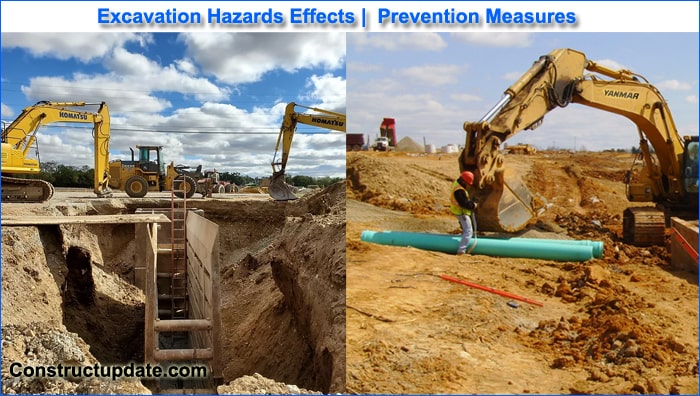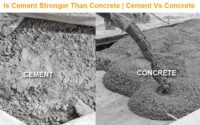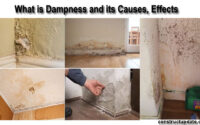Common Excavation Hazards and Control Measures
Excavation hazards are risks connected to removing dirt from building sites. Both the employees inside the trenches and those on the surface are in great danger during building site excavation. Therefore, safety precautions against the risks in the excavation must be taken into account. This article will discuss several excavation risks that can arise during site preparation as well as the safety precautions that need to be taken to minimise mishaps.
Types of Excavation Hazards
Excavation is the process of removing dirt or rock from a building site in order to make room for the installation of pipelines, equipment, etc. This space is then prepared for installation using various tools, machinery, or explosives. Therefore, excavation leaves a dangerous hole or cavity in its wake. At the building site, there are numerous excavation dangers. The biggest dangers are collapses or cave-ins. Other dangers consist of:
- Because of a lack of oxygen, asphyxiation
- Inhalation of toxic materials
- Fire
- Workers being struck by equipment or excavated soil.
- It is possible for an excavation to collapse if moving equipment is close to the edge.
- Falling, Slips, Trips
- The unintentional cutting of power or utility lines buried underneath.
- Material handling Hazards.
One of the riskiest building jobs is excavation. Most mishaps take place in ditches that are 1.2 to 4.5 m deep. Prior to a cave-in, there is frequently no warning.

Definitions related to Excavation Hazard
Excavation – a man-made trench, cut, hole, or depression made by removing earth.
Trench – a compact excavation The width is less than 4.5 metres, but the depth is bigger.
Shield – a building that can prevent a cave-in and keep people safe
Shoring – a building that supports an excavation’s sidewalls and prevents cave-ins
Sloping – a method that uses a certain angle of incline on the excavation’s sidewalls. Based on an evaluation of the site elements that have an impact, the angle changes.
Precautions from Excavation Hazards (Cave-ins)
Employers should use a protective system that is properly constructed to protect their workers from cave-ins. All anticipated loads on protective systems must be able to withstand them..
Protective system
A technique for shielding workers from cave-ins, material that might roll or fall into an excavation from an excavation face, and from the collapse of nearby structures. Protective systems includes
- support systems,
- sloping and benching systems,
- shield systems, and
- other systems that provide the necessary protection.
Requirements for Excavation Safety Plans
- A well-designed protective system
- Proper sloping and benching system design
- Correctly designed support, shield, and additional protective systems
- Proper equipment and material handling plus
- Pay close attention to how Equals should be installed and removed. Employee safety at excavation sites.
When creating a comprehensive “protective system,” a number of things are taken into consideration. The design of the system itself, the management of supplies and tools used in and around the dig, and the setting up and taking down of protective system parts.
Design of Protection Systems Against Risks and Hazards Associated with Excavation
The employer shall select and construct:
- Slopes and benching and sloping system configurations
- Support systems, shield systems, and additional defense mechanisms
- Shield – can either be stationary or mobile. also referred to as a trench box or trench
- Shoring – such a system that supports the sides with metal, hydraulic, mechanical, or wood shoring.
- Sloping – from an excavation’s sides that are angled in the opposite direction
Protect workers who may be exposed to cave-ins.
The following precautions can be implemented in order to safeguard employees from the risk of cave-in excavation:
- Keep at least 2 meters away from the cut’s edge, and use blocks to stop overrunning.
- Slope or bench the excavation’s sides.,
- Make the necessary preparations to secure the area being excavated.
- Support the excavation’s sides, or
- Put a shield between the work area and the excavation’s side.
Factors that Control the Excavation Protective System
When constructing a system to defend against the dangers and risks of excavation, several variables must be taken into account. Those are
- Soil classification
- Depth of cut
- The water content of the soil
- Changes due to weather and climate
- Other operations in the vicinity
- Support systems, shield systems, and other protective systems must be designed and built by the employer or someone he or she designates.
- Trenches longer than 5 feet must either have shoring or a stabilised slope.
- In order to conclude that a protective system is not required for soils where there is no sign of a probable cave-in, a competent person must check trenches less than 5 feet.
- Trenches under 5 feet need to be protected under dangerous soil conditions.
Shoring in Construction
In construction, shoring refers to creating a temporary framework to sustain ill-fated excavation walls or other structures until the job is done.
- Provides a foundation for labour
- Utilises uprights, cross braces, and Wales
- Wall supports for excavation
- Should be aware of the type of soil
- Must be aware of the excavation’s depth and width.
- Knowledge of the OSHA or other pertinent standards is required. Tables
- Trench Shield: The work area has to have a trench shield created around it.
Hydraulic Trench Support
The operator can quickly lower the system into the hole by using hydraulic jacks. Once the forms are in position, hydraulic pressure is raised to keep them there. Installing trench pins in the event of a hydraulic failure
Protection from Vehicles during excavation
- Install barricades
- Hand/mechanical signals
- Stop logs
- Grade soil away from the excavation
- Fence or barricade trenches left overnight
Hazardous Conditions
This is a very dangerous situation because of the crane’s weight and vibrations.
They have no business operating this crane.
In addition to the exposed trench, machinery that approaches too closely increases the risk of a cave-in.
Excavation may be impacted even by regular automobile traffic, such as that on an adjacent freeway or a road through an industrial area. Continuous or vigorous traffic may cause the soil to deteriorate and cave in due to vibrations.
Excavation Spoils
The soil, dirt, and debris collected during excavation are referred to as “excavation spoils.” To avoid risks from excavation wastes, the following factors should be taken into account.
- Avoid dumping debris within two feet of an excavation’s edge.
- Take a measurement from the excavation edge to the closest portion of the spoil.
- Put spoils where rainwater may escape the excavation
- Keep debris far from the excavation.
- Preventing Water from Creating Excavation Risks
- Water is Hazardous. So,
Employees are not allowed to work in excavations where water has accumulated or is accumulating unless sufficient measures have been made to safeguard them from the risks presented by the buildup. The measures required to adequately protect workers vary depending on the circumstance, but they may include the installation of safety harnesses and shield systems, water removal to regulate the level of accumulated water, or unique support or shield systems to prevent cave-ins.
If the usage of water removal equipment is used to regulate or prevent the accumulation of water, the equipment and operations must be monitored by a competent person to ensure appropriate operation.
Diversion ditches, dikes, or other appropriate measures must be utilised to prevent surface water from entering the excavation and to ensure that the area surrounding the excavation has adequate drainage if excavation activity interferes with the natural drainage of surface water (such as streams).
Hazardous Atmosphere
Before an employee enters an excavation deeper than 1.2 metres, it should be tested for:
- Oxygen deficiency
- High combustible gas concentration
- High levels of other hazardous substances
Employees are not allowed to work in potentially dangerous or poisonous environments. Such conditions consist of the following:
less than 19.5% oxygen, combustible gas concentrations that are higher than 20% of the lower flammable limit and concentrations of hazardous substances that are higher than those allowed by the ACGIH’s threshold limit values for airborne pollutants.
Means of Egress
All excavations 1.2 metres or deeper shall have a stairs, ladder, or ramp.
A competent individual must design structural ramps that are only utilised by employees to enter or exit from excavations. The design of structural ramps used for equipment entry or egress must be completed by a certified structural engineer, and the ramps must be built in line with the design.
Runways and ramps made of two or more structural members must be connected to one another in order to prevent displacement.
Ramp and runway structural components must be of uniform thickness.
Cleats or other suitable means used to connect runway structural parts must be fastened to the runway’s bottom or attached to avoid tripping hazards.
In order to prevent slippage, structural ramps that are used in place of steps must have cleats or other surface treatments on the top surface.
- Safeguarding against falls, falling objects, and moving equipment
- Install barricades
- Use hand / mechanical signals
- Grade soil away from the excavation
- Fence or barricade trenches left overnight
- When warnings, signals, and barricades are insufficient, use a flagger.
Site Evaluation Planning
Before beginning excavation:
- Evaluate soil conditions
- Construct protective systems
- Test for low oxygen, hazardous fumes, and toxic gases
- Provide safe in and out access
- Underground services
- Determine the safety equipment needed
Summary
A cave-in is the biggest danger during an excavation.
By sloping, sheltering, and shoring the excavation, workers can be kept safe.
It is the responsibility of a qualified person to inspect the excavation.
Other excavation risks include water buildup, a lack of oxygen, toxic gases, falls, and moving machinery.





